Order-6 hexagonal tiling honeycomb
| Order-6 hexagonal tiling honeycomb | |
|---|---|
 Perspective projection view from center of Poincaré disk model | |
| Type | Hyperbolic regular honeycomb Paracompact uniform honeycomb |
| Schläfli symbol | {6,3,6} {6,3[3]} |
| Coxeter diagram | |
| Cells | {6,3} |
| Faces | hexagon {6} |
| Edge figure | hexagon {6} |
| Vertex figure | {3,6} or {3[3]} |
| Dual | Self-dual |
| Coxeter group | Z3, [6,3,6] VP3, [6,3[3]] |
| Properties | Regular, quasiregular |
In the field of hyperbolic geometry, the order-6 hexagonal tiling honeycomb arises one of 11 regular paracompact honeycombs in 3-dimensional hyperbolic space. It is called paracompact because it has infinite cells. Each cell consists of a hexagonal tiling whose vertices lie on a horosphere: a flat plane in hyperbolic space that approaches a single ideal point at infinity.
The Schläfli symbol of the hexagonal tiling honeycomb is {6,3,6}. Since that of the hexagonal tiling of the plane is {6,3}, this honeycomb has six such hexagonal tilings meeting at each edge. Since the Schläfli symbol of the triangular tiling is {3,6}, the vertex figure of this honeycomb is a triangular tiling. Thus, infinitely many hexagonal tilings meet at each vertex of this honeycomb.[1]
A geometric honeycomb is a space-filling of polyhedral or higher-dimensional cells, so that there are no gaps. It is an example of the more general mathematical tiling or tessellation in any number of dimensions.
Honeycombs are usually constructed in ordinary Euclidean ("flat") space, like the convex uniform honeycombs. They may also be constructed in non-Euclidean spaces, such as hyperbolic uniform honeycombs. Any finite uniform polytope can be projected to its circumsphere to form a uniform honeycomb in spherical space.
Images
It is analogous to the 2D hyperbolic infinite-order apeirogonal tiling, {∞,∞} with infinite apeirogonal faces and with all vertices are on the ideal surface.
This honeycomb contains ![]()
![]()
![]()
![]()
![]() ,
, ![]()
![]()
![]()
![]()
![]() that tile 2-hypercycle surfaces, similar to the paracompact tilings,
that tile 2-hypercycle surfaces, similar to the paracompact tilings, ![]()
![]()
![]()
![]()
![]() ,
, ![]()
![]()
![]()
![]()
![]() :
:
Symmetry
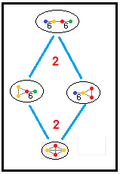
This honeycomb has a half symmetry construction is ![]()
![]()
![]()
![]()
![]() , which looks identical by cells and needs faces colored by their symmetry position to be distinct. Another lower symmetry, [6,3*,6], index 6 exists with a nonsimplex fundamental domain. It has an octahedral Coxeter diagram with 6 order-3 branches, and 3 infinite-order branches in the shape of a triangular prism,
, which looks identical by cells and needs faces colored by their symmetry position to be distinct. Another lower symmetry, [6,3*,6], index 6 exists with a nonsimplex fundamental domain. It has an octahedral Coxeter diagram with 6 order-3 branches, and 3 infinite-order branches in the shape of a triangular prism, ![]()
![]()
![]()
![]()
![]()
![]()
![]() .
.
Related polytopes and honeycombs
It is one of 15 regular hyperbolic honeycombs in 3-space, 11 of which like this one are paracompact, with infinite cells or vertex figures.
| 11 paracompact regular honeycombs | |||||||||||
|---|---|---|---|---|---|---|---|---|---|---|---|
 {6,3,3} |
 {6,3,4} |
 {6,3,5} |
 {6,3,6} |
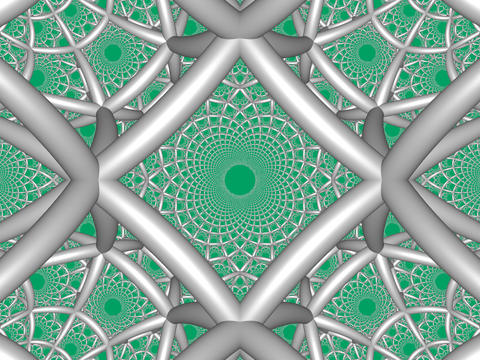 {4,4,3} |
 {4,4,4} | ||||||
 {3,3,6} |
 {4,3,6} |
 {5,3,6} |
 {3,6,3} |
 {3,4,4} | |||||||
There are nine uniform honeycombs in the [6,3,6] Coxeter group family, including this regular form.
| {6,3,6} |
r{6,3,6} |
t{6,3,6} |
rr{6,3,6} |
t0,3{6,3,6} |
2t{6,3,6} |
tr{6,3,6} |
t0,1,3{6,3,6} |
t0,1,2,3{6,3,6} |
|---|---|---|---|---|---|---|---|---|
 |
 |
 |
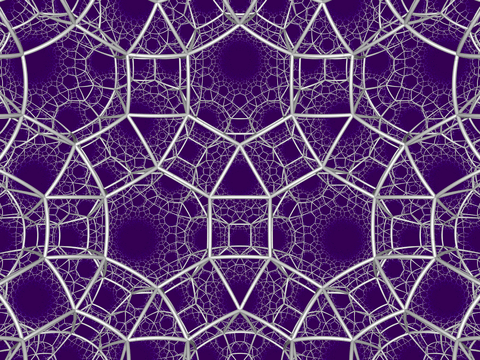 |
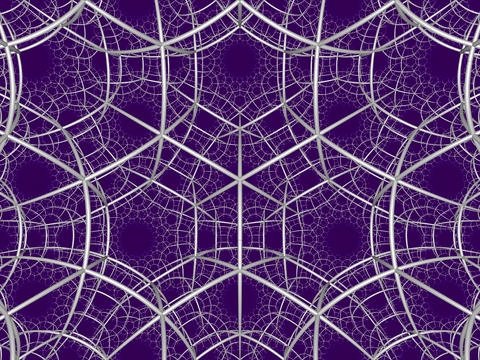 |
 |
 |
 |
 |
It has a related alternation honeycomb, represented by ![]()
![]()
![]()
![]()
![]()
![]()
![]() ↔
↔ ![]()
![]()
![]()
![]()
![]() , having alternating triangular tiling cells, and a regular form as
, having alternating triangular tiling cells, and a regular form as ![]()
![]()
![]()
![]()
![]()
![]()
![]() , called a triangular tiling honeycomb.
, called a triangular tiling honeycomb.
This honeycomb is a part of a sequence of polychora and honeycombs with triangular tiling vertex figures:
| Form | Paracompact | Noncompact | |||||
|---|---|---|---|---|---|---|---|
| Name | {3,3,6} | {4,3,6} | {5,3,6} | {6,3,6} | {7,3,6} | {8,3,6} | ... {∞,3,6} |
| Image |  |
 |
 |
 |
|||
| Cells | {3,3} |
{4,3} |
{5,3} |
{6,3} |
{7,3} |
{8,3} |
{∞,3} |
| {6,3,p} honeycombs | |||||||||||
|---|---|---|---|---|---|---|---|---|---|---|---|
| Space | H3 | ||||||||||
| Form | Paracompact | Noncompact | |||||||||
| Name | {6,3,3} | {6,3,4} | {6,3,5} | {6,3,6} | {6,3,7} |
{6,3,8} |
... {6,3,∞} | ||||
| Coxeter |
|||||||||||
| Image |  |
 |
 |
 |
 |
 | |||||
| Vertex figure {3,p} |
{3,3} |
{3,4} |
{3,5} |
{3,6} |
{3,7} |
{3,8} |
{3,∞} | ||||
| {p,3,p} regular honeycombs | |||||||||||
|---|---|---|---|---|---|---|---|---|---|---|---|
| Space | S3 | Euclidean E3 | H3 | ||||||||
| Form | Finite | Affine | Compact | Paracompact | Noncompact | ||||||
| Name | {3,3,3} | {4,3,4} | {5,3,5} | {6,3,6} | {7,3,7} | {8,3,8}... | {∞,3,∞} | ||||
| Image |  |
 |
 |
 |
|||||||
| Cells |  {3,3} |
 {4,3} |
 {5,3} |
 {6,3} |
 {7,3} |
 {8,3} |
 {∞,3} | ||||
| Vertex figure |
 {3,3} |
 {3,4} |
 {3,5} |
 {3,6} |
 {3,7} |
 {3,8} |
 {3,∞} | ||||
Rectified order-6 hexagonal tiling honeycomb
| Rectified order-6 hexagonal tiling honeycomb | |
|---|---|
| Type | Paracompact uniform honeycomb |
| Schläfli symbols | r{6,3,6} or t1{6,3,6} |
| Coxeter diagrams | |
| Cells | {3,6} r{6,3} |
| Faces | Triangle {3} Hexagon {6} |
| Vertex figure |  Hexagonal prism {}×{6} |
| Coxeter groups | Z3, [6,3,6] DV3, [6,3[3]] [4,3[3]] [3[3,3]] |
| Properties | Vertex-transitive, edge-transitive |
The rectified order-6 hexagonal tiling honeycomb, t1{6,3,6}, ![]()
![]()
![]()
![]()
![]()
![]()
![]() has tetrahedral and trihexagonal tiling facets, with a hexagonal prism vertex figure.
has tetrahedral and trihexagonal tiling facets, with a hexagonal prism vertex figure.
it can also be seen as a quarter order-6 hexagonal tiling honeycomb, q{6,3,6}, ![]()
![]()
![]()
![]()
![]()
![]()
![]() or
or ![]()
![]()
![]() .
.

It is analogous to 2D hyperbolic order-4 apeirogonal tiling, r{∞,∞} with infinite apeirogonal faces and with all vertices are on the ideal surface.
Related honeycombs
| Space | H3 | ||||||
|---|---|---|---|---|---|---|---|
| Form | Paracompact | Noncompact | |||||
| Name | r{3,3,6} |
r{4,3,6} |
r{5,3,6} |
r{6,3,6} |
r{7,3,6} |
... r{∞,3,6} | |
| Image | 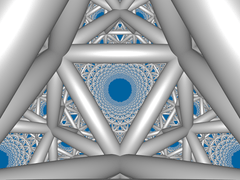 |
 |
 |
 |
|||
| Cells {3,6} |
r{3,3} |
r{4,3} |
r{6,3} |
r{6,3} |
r{∞,3} |
r{∞,3} | |
The order-6 hexagonal tiling honeycomb is related to a matrix of 3-dimensional honeycombs: q{2p,4,2q}
| Euclidean/hyperbolic(paracompact/noncompact) quarter honeycombs q{p,3,q} | |||||||||||
|---|---|---|---|---|---|---|---|---|---|---|---|
| p \ q | 4 | 6 | 8 | ... ∞ | |||||||
| 4 |  q{4,3,4} |
q{4,3,6} |
q{4,3,8} |
q{4,3,∞} | |||||||
| 6 | q{6,3,4} |
 q{6,3,6} |
q{6,3,8} |
q{6,3,∞} | |||||||
| 8 | q{8,3,4} |
q{8,3,6} |
q{8,3,8} |
q{8,3,∞} | |||||||
| ... ∞ | q{∞,3,4} |
q{∞,3,6} |
q{∞,3,8} |
q{∞,3,∞} | |||||||
Truncated order-6 hexagonal tiling honeycomb
| Truncated order-6 hexagonal tiling honeycomb | |
|---|---|
| Type | Paracompact uniform honeycomb |
| Schläfli symbol | t{6,3,6} or t0,1{6,3,6} |
| Coxeter diagram | |
| Cells | {3,6} t{6,3} |
| Faces | Triangle {3} Dodecagon {12} |
| Vertex figure |  hexagonal pyramid |
| Coxeter groups | Z3, [6,3,6] DV3, [6,3[3]] |
| Properties | Vertex-transitive |
The truncated order-6 hexagonal tiling honeycomb, t0,1{6,3,6}, ![]()
![]()
![]()
![]()
![]()
![]()
![]() has tetrahedral and truncated hexagonal tiling facets, with a tetrahedral vertex figure.
has tetrahedral and truncated hexagonal tiling facets, with a tetrahedral vertex figure.

Bitruncated order-6 hexagonal tiling honeycomb
The bitruncated order-6 hexagonal tiling honeycomb is a lower symmetry construction of the regular hexagonal tiling honeycomb, ![]()
![]()
![]()
![]()
![]()
![]()
![]() ↔
↔ ![]()
![]()
![]()
![]()
![]()
![]()
![]() .
.
Cantellated order-6 hexagonal tiling honeycomb
| Cantellated order-6 hexagonal tiling honeycomb | |
|---|---|
| Type | Paracompact uniform honeycomb |
| Schläfli symbol | rr{6,3,6} or t0,2{6,3,6} |
| Coxeter diagram | |
| Cells | r{3,6} rr{6,3} |
| Faces | Triangle {3} square {4} hexagon {6} |
| Vertex figure |  triangular prism |
| Coxeter groups | Z3, [6,3,6] DV3, [6,3[3]] |
| Properties | Vertex-transitive |
The cantellated order-6 hexagonal tiling honeycomb, t0,2{6,3,6}, ![]()
![]()
![]()
![]()
![]()
![]()
![]() has trihexagonal tiling and rhombitrihexagonal tiling cells, with a triangular prism vertex figure.
has trihexagonal tiling and rhombitrihexagonal tiling cells, with a triangular prism vertex figure.

Cantitruncated order-6 hexagonal tiling honeycomb
| Cantitruncated order-6 hexagonal tiling honeycomb | |
|---|---|
| Type | Paracompact uniform honeycomb |
| Schläfli symbol | tr{6,3,6} or t0,1,2{6,3,6} |
| Coxeter diagram | |
| Cells | tr{3,6} t{3,6} |
| Faces | Triangle {3} hexagon {6} dodecagon {12} |
| Vertex figure |  triangular prism |
| Coxeter groups | Z3, [6,3,6] DV3, [6,3[3]] |
| Properties | Vertex-transitive |
The cantitruncated order-6 hexagonal tiling honeycomb, t0,1,2{6,3,6}, ![]()
![]()
![]()
![]()
![]()
![]()
![]() has hexagonal tiling and truncated trihexagonal tiling cells, with a triangular prism vertex figure.
has hexagonal tiling and truncated trihexagonal tiling cells, with a triangular prism vertex figure.

Runcinated order-6 hexagonal tiling honeycomb
| Runcinated order-6 hexagonal tiling honeycomb | |
|---|---|
| Type | Paracompact uniform honeycomb |
| Schläfli symbol | t0,3{6,3,6} |
| Coxeter diagram | |
| Cells | {6,3} {}×{6} |
| Faces | Triangle {3} square {4} hexagon {6} |
| Vertex figure |  triangular antiprism |
| Coxeter groups | 2×Z3, [[6,3,6]] |
| Properties | Vertex-transitive, edge-transitive |
The runcinated order-6 hexagonal tiling honeycomb, t0,3{6,3,6}, ![]()
![]()
![]()
![]()
![]()
![]()
![]() has hexagonal tiling and hexagonal prism cells, with a triangular antiprism vertex figure.
has hexagonal tiling and hexagonal prism cells, with a triangular antiprism vertex figure.

It is analogous to the 2D hyperbolic rhombihexahexagonal tiling, rr{6,6}, ![]()
![]()
![]()
![]()
![]() with square and hexagonal faces:
with square and hexagonal faces:
Runcitruncated order-6 hexagonal tiling honeycomb
| Runcitruncated order-6 hexagonal tiling honeycomb | |
|---|---|
| Type | Paracompact uniform honeycomb |
| Schläfli symbol | t0,1,3{6,3,6} |
| Coxeter diagram | |
| Cells | t{6,3} rr{6,3} {}x{6} {}x{12} |
| Faces | Triangle {3} square {4} hexagon {6} dodecagon {12} |
| Vertex figure | |
| Coxeter groups | Z3, [6,3,6] |
| Properties | Vertex-transitive |
The runcitruncated order-6 hexagonal tiling honeycomb, t0,1,3{6,3,6}, ![]()
![]()
![]()
![]()
![]()
![]()
![]() has Truncated hexagonal tiling, rhombitrihexagonal tiling, hexagonal prism, and dodecagonal prism cells.
has Truncated hexagonal tiling, rhombitrihexagonal tiling, hexagonal prism, and dodecagonal prism cells.

Omnitruncated order-6 hexagonal tiling honeycomb
| Omnitruncated order-6 hexagonal tiling honeycomb | |
|---|---|
| Type | Paracompact uniform honeycomb |
| Schläfli symbol | t0,1,2,3{6,3,6} |
| Coxeter diagram | |
| Cells | tr{6,3} {}x{12} |
| Faces | square {4} hexagon {6} dodecagon {12} |
| Vertex figure |  Phyllic disphenoid |
| Coxeter groups | 2×Z3, [[6,3,6]] |
| Properties | Vertex-transitive |
The omnitruncated order-6 hexagonal tiling honeycomb, t0,1,2,3{6,3,6}, ![]()
![]()
![]()
![]()
![]()
![]()
![]() has rhombitrihexagonal tiling and dodecagonal prism cells, with a tetrahedron vertex figure.
has rhombitrihexagonal tiling and dodecagonal prism cells, with a tetrahedron vertex figure.

Alternated order-6 hexagonal tiling honeycomb
The alternated order-6 hexagonal tiling honeycomb is a lower symmetry construction of the regular triangular tiling honeycomb, ![]()
![]()
![]()
![]()
![]()
![]()
![]() ↔
↔ ![]()
![]()
![]()
![]()
![]() .
.
Cantic order-6 hexagonal tiling honeycomb
The cantic order-6 hexagonal tiling honeycomb is a lower symmetry construction of the rectified triangular tiling honeycomb, ![]()
![]()
![]()
![]()
![]()
![]()
![]() ↔
↔ ![]()
![]()
![]()
![]()
![]()
Runcic order-6 hexagonal tiling honeycomb
| Runcic order-6 hexagonal tiling honeycomb | |
|---|---|
| Type | Paracompact uniform honeycomb |
| Schläfli symbols | h3{6,3,6} |
| Coxeter diagrams | |
| Cells | {3,6} {}x{3} rr{3,6} {3,6} |
| Faces | Triangle {3} Hexagon {6} |
| Vertex figure |  Triangular cupola |
| Coxeter groups | , [6,3[3]] |
| Properties | Vertex-transitive |
The runcic hexagonal tiling honeycomb, h3{6,3,6}, ![]()
![]()
![]()
![]()
![]()
![]()
![]() or
or ![]()
![]()
![]()
![]()
![]() .
.
Runicantic order-6 hexagonal tiling honeycomb
| Runcicantic order-6 hexagonal tiling honeycomb | |
|---|---|
| Type | Paracompact uniform honeycomb |
| Schläfli symbols | h2,3{6,3,6} |
| Coxeter diagrams | |
| Cells | tr{6,3} {}x{3} tr{3,6} r{3,6} |
| Faces | Triangle {3} Square {4} Hexagon {6} |
| Vertex figure |  |
| Coxeter groups | , [6,3[3]] |
| Properties | Vertex-transitive |
The runcicantic order-6 hexagonal tiling honeycomb, h2,3{6,3,6}, ![]()
![]()
![]()
![]()
![]()
![]()
![]() or
or ![]()
![]()
![]()
![]()
![]() .
.
See also
References
- ↑ Coxeter The Beauty of Geometry, 1999, Chapter 10, Table III
- Coxeter, Regular Polytopes, 3rd. ed., Dover Publications, 1973. ISBN 0-486-61480-8. (Tables I and II: Regular polytopes and honeycombs, pp. 294–296)
- The Beauty of Geometry: Twelve Essays (1999), Dover Publications, LCCN 99-35678, ISBN 0-486-40919-8 (Chapter 10, Regular Honeycombs in Hyperbolic Space) Table III
- Jeffrey R. Weeks The Shape of Space, 2nd edition ISBN 0-8247-0709-5 (Chapter 16-17: Geometries on Three-manifolds I,II)
- Norman Johnson Uniform Polytopes, Manuscript
- N.W. Johnson: The Theory of Uniform Polytopes and Honeycombs, Ph.D. Dissertation, University of Toronto, 1966
- N.W. Johnson: Geometries and Transformations, (2015) Chapter 13: Hyperbolic Coxeter groups



